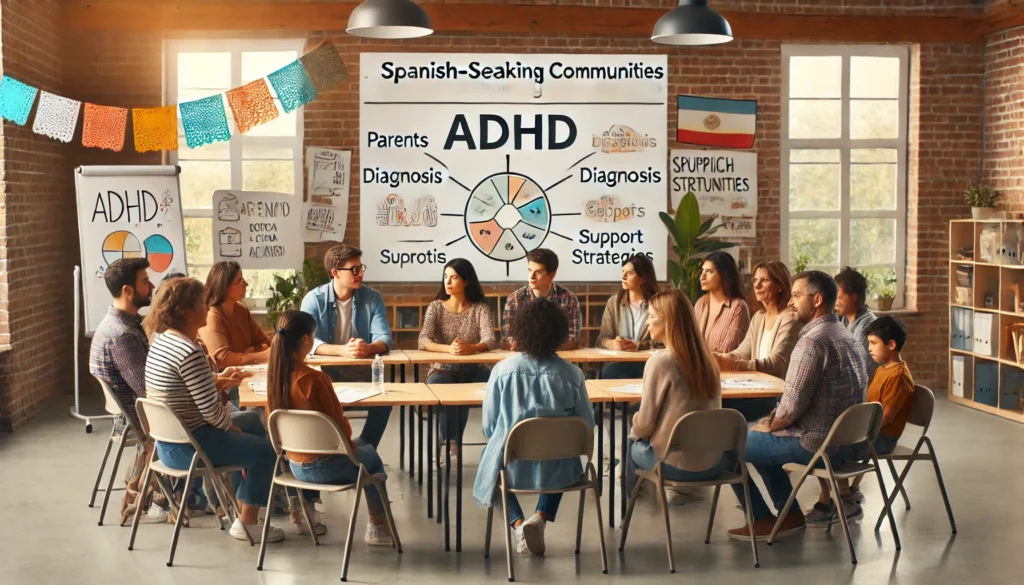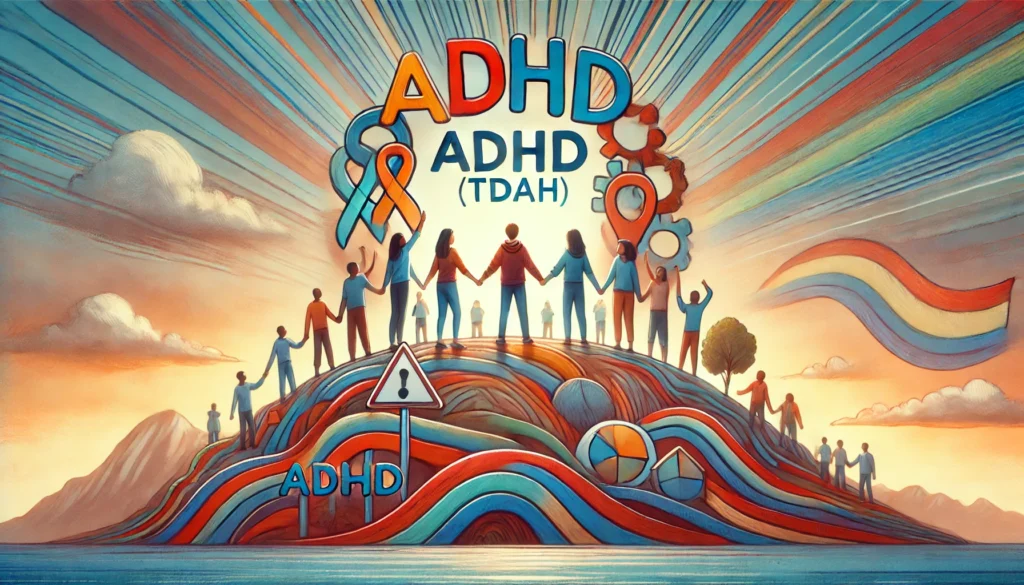Attention-Deficit/Hyperactivity Disorder (ADHD), or Trastorno por Déficit de Atención e Hiperactividad (TDAH) in Spanish, has increasingly become a focal point of discussion in both the medical community and public discourse. The Special Interest Group (SIG) dedicated to TDAH is pivotal in this dialogue, driving forward research, policy discussions, and awareness initiatives. In this article, we delve into the impact of TDAH SIG, its contributions to understanding ADHD symptoms in Spanish-speaking populations, and the broader implications for mental health awareness.
You may also like: Enhancing Concentration: Strategies for ADHD
The Role of TDAH SIG in ADHD Awareness
The TDAH SIG serves as a cornerstone for researchers, clinicians, and educators interested in ADHD. By facilitating collaboration and communication, this group enhances our understanding of ADHD’s complexities, particularly in Spanish-speaking populations where cultural nuances can affect diagnosis and treatment.
Bridging Cultural Gaps
One of the significant contributions of TDAH SIG is its role in bridging cultural gaps. ADHD symptoms in Spanish-speaking communities can manifest differently due to cultural attitudes toward mental health and varying healthcare access levels. By focusing on these communities, TDAH SIG helps tailor interventions that are culturally sensitive and effective.
Cultural perceptions of mental health vary widely, influencing how ADHD is perceived and addressed. In some communities, mental health issues may be stigmatized, leading to underdiagnosis. TDAH SIG works to educate these communities, promoting understanding and acceptance of ADHD as a legitimate condition.
Language also plays a crucial role in the diagnosis and treatment of ADHD. TDAH SIG’s efforts include developing resources in Spanish that are accessible and relevant to these communities, ensuring that language barriers do not impede understanding and care.
Advancing Research and Education
TDAH SIG’s initiatives in research and education provide invaluable resources for health and wellness coaches, science journalists, and biohackers. Through conferences, publications, and online resources, the group disseminates the latest findings and best practices, helping professionals stay informed and apply this knowledge in real-world settings.
The group organizes regular workshops and seminars that focus on the latest ADHD research, providing platforms for experts to share insights and developments. These events are crucial for fostering a collaborative research environment that encourages innovation and progress.
Education is a core component of TDAH SIG’s mission, and the group has established various educational programs aimed at both professionals and the general public. These programs are designed to increase understanding of ADHD, highlight the importance of early diagnosis, and provide strategies for management.
The digital age has transformed how information is shared, and TDAH SIG utilizes online platforms to reach a wider audience. Their online resources include webinars, podcasts, and interactive tools that make ADHD education accessible to people regardless of their location.
Collaborative Networks
Building collaborative networks is essential for the success of TDAH SIG’s initiatives. By forming partnerships with other organizations, including academic institutions and healthcare providers, the group can leverage resources and expertise.
These collaborations often result in joint research projects that explore various aspects of ADHD, from genetic factors to environmental influences. Such projects are instrumental in advancing our understanding of the disorder and developing new treatment approaches.
Networking also facilitates the exchange of ideas and best practices, allowing TDAH SIG to incorporate diverse perspectives into their initiatives. This inclusivity ensures that their efforts are comprehensive and address the needs of different communities.

ADHD Symptoms and Diagnosis in Spanish-Speaking Populations
Understanding ADHD symptoms in Spanish-speaking populations requires a nuanced approach. Language barriers, stigmatization, and differing healthcare systems can all influence how symptoms are perceived and diagnosed.
Common Symptoms
ADHD symptoms can include inattention, hyperactivity, and impulsivity. However, these symptoms might be expressed differently in various cultural contexts. For example, what might be considered inattentiveness in one culture could be viewed as a lack of discipline in another. TDAH SIG works to ensure that diagnostic criteria are applied equitably across different cultural backgrounds.
In Spanish-speaking communities, symptoms of ADHD might be overlooked or misinterpreted due to cultural beliefs about behavior and discipline. TDAH SIG focuses on educating these communities about the nature of ADHD, helping to differentiate between cultural norms and clinical symptoms.
The group also emphasizes the importance of observing symptoms across different settings, such as home and school, to gain a comprehensive understanding of the individual’s behavior. This holistic approach aids in accurate diagnosis and effective intervention strategies.
Parents and caregivers play a vital role in recognizing ADHD symptoms, and TDAH SIG provides resources to help them identify potential signs of the disorder. By empowering families with knowledge, the group helps facilitate timely diagnosis and access to appropriate care.
Importance of Accurate Diagnosis
Accurate diagnosis is crucial for effective treatment and management of ADHD. Misdiagnosis can lead to inappropriate interventions, exacerbating the condition. By promoting research and training, TDAH SIG helps improve diagnostic accuracy, ensuring that individuals receive the care they need.
TDAH SIG advocates for comprehensive assessments that consider various factors, including cultural background and language proficiency, to ensure accurate diagnosis. These assessments help differentiate ADHD from other conditions with similar symptoms.
The group also focuses on training healthcare professionals in culturally competent practices, equipping them with the skills needed to assess and diagnose ADHD accurately in diverse populations. This training is essential for reducing diagnostic disparities and improving outcomes.
Early and accurate diagnosis is linked to better long-term outcomes for individuals with ADHD. TDAH SIG’s initiatives aim to raise awareness about the importance of timely diagnosis, encouraging families and healthcare providers to seek evaluation at the first signs of symptoms.
Overcoming Diagnostic Challenges
Several challenges can impede the diagnosis of ADHD in Spanish-speaking populations, including language barriers, lack of access to healthcare, and stigma. TDAH SIG addresses these challenges through targeted interventions and advocacy efforts.
Language barriers can prevent effective communication between patients and healthcare providers, leading to misdiagnosis. TDAH SIG works to provide translation services and culturally appropriate diagnostic tools to bridge this gap.
Access to healthcare is another significant challenge, particularly in under-resourced areas. TDAH SIG advocates for policy changes that improve access to mental health services, ensuring that all individuals, regardless of their background, can receive appropriate care.
Stigma surrounding mental health can discourage individuals from seeking diagnosis and treatment. TDAH SIG’s awareness campaigns focus on reducing stigma by promoting understanding and acceptance of ADHD within communities.

The Broader Impact of TDAH SIG Initiatives
TDAH SIG’s efforts extend beyond immediate clinical outcomes, influencing public policy, education systems, and societal attitudes towards ADHD.
Policy and Advocacy
Through advocacy, TDAH SIG influences policy development, ensuring that ADHD is recognized as a legitimate mental health condition requiring appropriate resources. This advocacy is vital for securing funding for research and support services, particularly in under-resourced areas.
TDAH SIG collaborates with policymakers to develop legislation that supports individuals with ADHD, such as laws mandating insurance coverage for mental health services and funding for educational accommodations. These policies are essential for providing comprehensive support.
The group also engages in public awareness campaigns to educate stakeholders about the impact of ADHD, advocating for increased funding and resources for research and treatment. These efforts help ensure that ADHD remains a priority on the public health agenda.
Advocacy efforts are often supported by data and research findings, which TDAH SIG uses to inform policymakers about the needs and challenges faced by individuals with ADHD. This evidence-based approach helps drive meaningful policy change.
Educational Impact
In education, TDAH SIG’s work supports the development of inclusive teaching strategies that accommodate students with ADHD. By raising awareness and providing training for educators, the group helps create learning environments where all students can thrive.
TDAH SIG develops training programs for teachers, equipping them with the skills needed to recognize ADHD symptoms and implement effective classroom management strategies. These programs are vital for fostering an inclusive educational environment.
The group also advocates for individualized education plans (IEPs) and other accommodations that support students with ADHD, ensuring they have the necessary resources to succeed academically. These accommodations can include extended test times, quiet workspaces, and specialized instruction.
By partnering with schools and educational institutions, TDAH SIG facilitates the integration of ADHD education into the curriculum, promoting understanding among students and staff. This knowledge helps reduce stigma and create a supportive school culture.
Societal Attitudes
Finally, by raising awareness about ADHD, TDAH SIG plays a crucial role in shifting societal attitudes. By normalizing discussions around mental health, the group helps reduce stigma and encourage individuals to seek help without fear of judgment.
Public awareness campaigns are a key component of TDAH SIG’s strategy for changing societal attitudes. These campaigns use various media platforms to disseminate information about ADHD, challenging stereotypes and misconceptions.
Community engagement is another important aspect of TDAH SIG’s efforts. By involving local leaders, influencers, and organizations in their initiatives, the group fosters community support and understanding of ADHD.
The group also promotes storytelling and personal narratives from individuals with ADHD and their families, highlighting the diversity of experiences and the importance of empathy and support. These stories humanize the disorder and inspire compassion and acceptance.

Future Directions for TDAH SIG
As we look to the future, the work of TDAH SIG will continue to evolve in response to emerging research and changing societal needs. Here are some potential directions for the group’s future initiatives:
Integrating Technology in ADHD Management
The integration of technology in ADHD management is a promising area for future exploration. From digital platforms that facilitate remote consultations to apps designed to help manage symptoms, technology offers new avenues for support and intervention.
TDAH SIG is exploring the use of telehealth services to provide remote consultations and therapy sessions for individuals with ADHD. These services increase access to care, especially for those in remote or underserved areas.
The group is also investigating the potential of mobile apps and digital tools that assist with symptom tracking, medication reminders, and behavioral interventions. These tools can empower individuals to manage their ADHD effectively and independently.
Virtual reality (VR) and artificial intelligence (AI) are emerging technologies that hold promise for ADHD management. TDAH SIG is at the forefront of researching how these technologies can be leveraged to enhance therapeutic outcomes and provide personalized care.
Expanding Global Outreach
Expanding TDAH SIG’s global outreach will be crucial for addressing ADHD in diverse populations. By collaborating with international partners, the group can share knowledge and resources, enhancing global understanding of ADHD.
International partnerships enable TDAH SIG to engage with organizations worldwide, fostering a global exchange of ideas and best practices. These collaborations are essential for developing culturally sensitive approaches to ADHD diagnosis and treatment.
The group also aims to establish regional chapters in various countries, providing localized support and resources. These chapters will help address the specific needs of different communities while maintaining a unified global mission.
Global outreach efforts include participating in international conferences and forums, where TDAH SIG can present research findings and advocate for global awareness and action on ADHD. These platforms are vital for influencing international policies and practices.
Encouraging Interdisciplinary Research
Interdisciplinary research will be key to unraveling the complexities of ADHD. By encouraging collaborations between neuroscientists, psychologists, educators, and sociologists, TDAH SIG can foster comprehensive studies that provide deeper insights into the disorder.
Interdisciplinary research projects bring together experts from various fields to explore ADHD from multiple perspectives. These projects can lead to new discoveries about the biological, psychological, and social factors that contribute to the disorder.
TDAH SIG supports grants and funding opportunities for interdisciplinary research initiatives, encouraging innovative studies that push the boundaries of current knowledge. These initiatives are crucial for advancing our understanding of ADHD.
Workshops and symposiums organized by TDAH SIG provide platforms for researchers from different disciplines to share their findings and collaborate on future projects. These events are essential for building a collaborative research community focused on ADHD.
Conclusion
The impact of TDAH SIG is profound, not only in terms of advancing research and improving clinical outcomes but also in shaping societal perceptions and policies regarding ADHD. By continuing to support the work of this vital group, we can ensure that individuals with ADHD receive the understanding, support, and resources they need to thrive. As we move forward, the ongoing efforts of TDAH SIG will undoubtedly play a crucial role in the evolving landscape of mental health awareness and treatment.
With a commitment to bridging cultural gaps, advancing research, and advocating for policy change, TDAH SIG remains at the forefront of ADHD discourse, driving meaningful change and fostering a more inclusive and informed society. Through collaborative efforts and innovative initiatives, the group is poised to make lasting contributions to the field of mental health, ensuring that ADHD is recognized and addressed with the care and attention it deserves.
Further Reading:
Understanding Attention-Deficit/Hyperactivity Disorder From Childhood to Adulthood
What the Heck Is “TDAH” vs. ADHD?
Important Note: The information contained in this article is for general informational purposes only, and should not be construed as health or medical advice, nor is it intended to diagnose, prevent, treat, or cure any disease or health condition. Before embarking on any diet, fitness regimen, or program of nutritional supplementation, it is advisable to consult your healthcare professional in order to determine its safety and probable efficacy in terms of your individual state of health.
Regarding Nutritional Supplements Or Other Non-Prescription Health Products: If any nutritional supplements or other non-prescription health products are mentioned in the foregoing article, any claims or statements made about them have not been evaluated by the U.S. Food and Drug Administration, and such nutritional supplements or other health products are not intended to diagnose, treat, cure, or prevent any disease.


